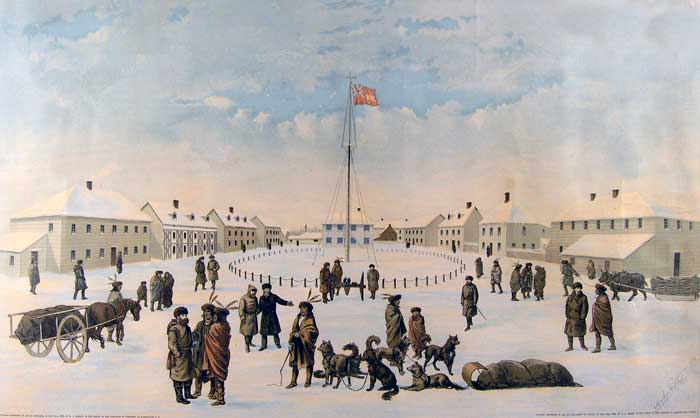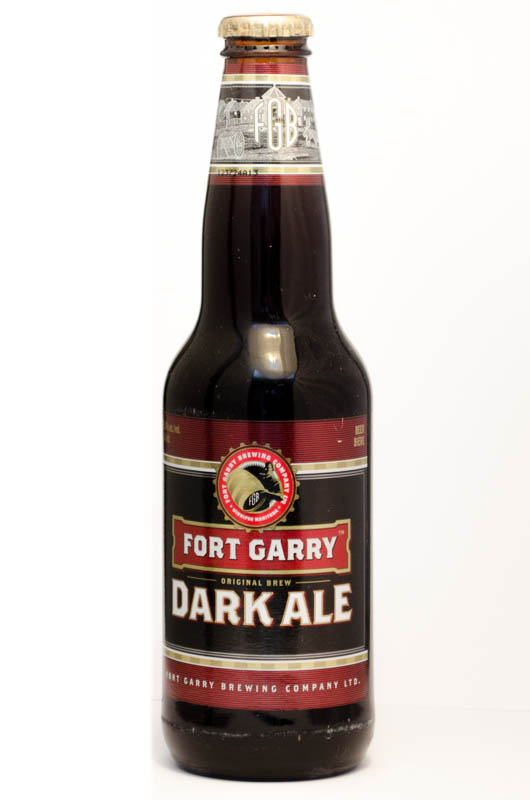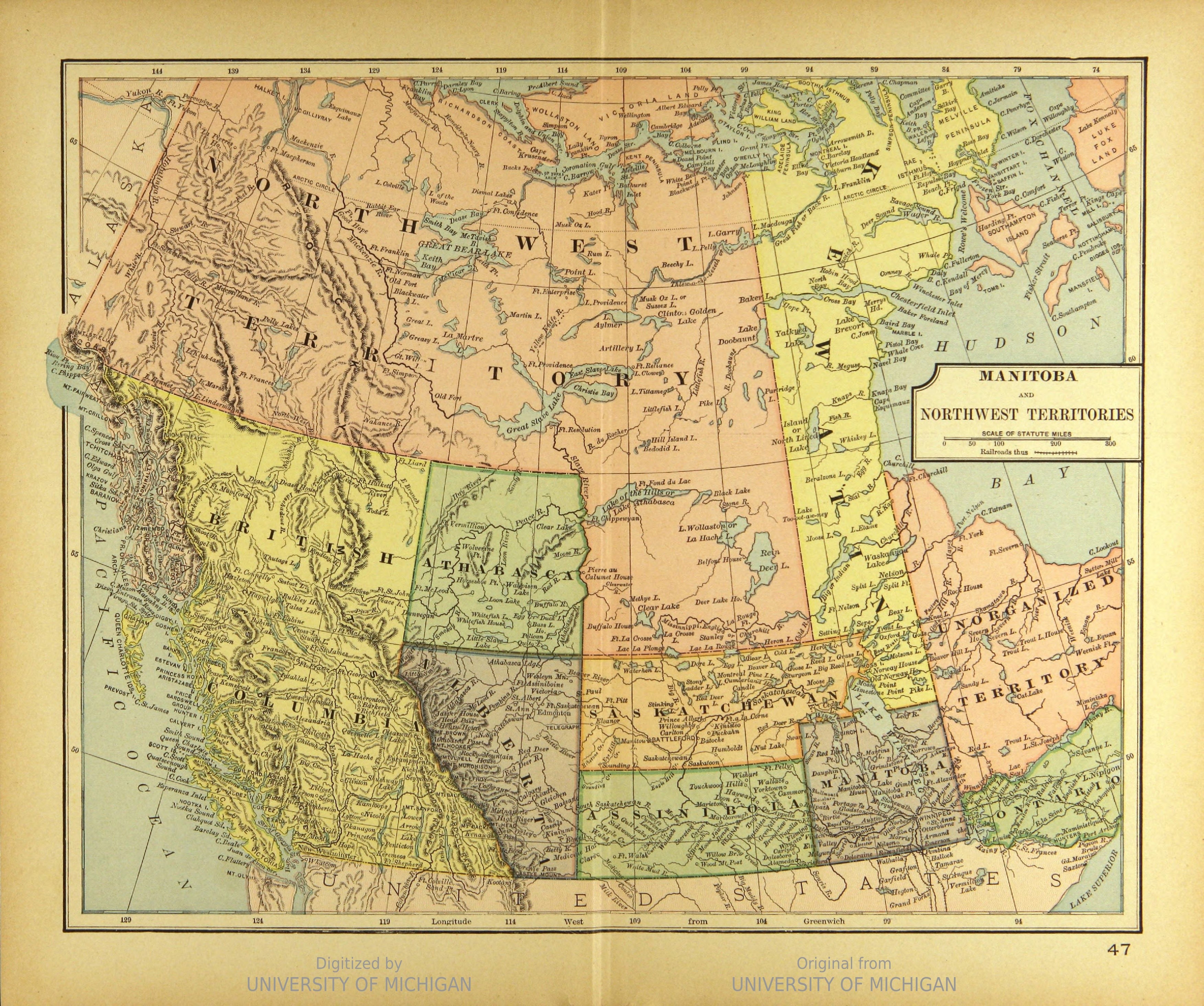|
Upper Fort Garry
Fort Garry, also known as Upper Fort Garry, was a Hudson's Bay Company trading post located at the confluence of the Red and Assiniboine rivers in or near the area now known as The Forks in what is now central Winnipeg, Manitoba. Fort Garry was established in 1822, although its first iteration was destroyed in 1826 by severe flooding. The trading post was rebuilt in 1836 and served as the administrative centre for the Red River Colony. From 1869 to 1870, the fort was briefly occupied by Louis Riel and his Métis followers during the Red River Rebellion. The fort was demolished in the 1880s to make way for Winnipeg's Main Street, although the fort's gate remains. The site of the former fort was designated as a part of a larger National Historic Site in 1924. Development of a provincial heritage site on the historic site of Fort Garry began in the early 21st century. History Fort Garry was established by the Hudson's Bay Company (HBC) in 1822 on or near the site of the North ... [...More Info...] [...Related Items...] OR: [Wikipedia] [Google] [Baidu] |
Winnipeg
Winnipeg () is the capital and largest city of the Provinces and territories of Canada, Canadian province of Manitoba. It is centred on the confluence of the Red River of the North, Red and Assiniboine River, Assiniboine rivers. , Winnipeg had a city population of 749,607 and a metropolitan population of 834,678, making it Canada's List of the largest municipalities in Canada by population, sixth-largest city and List of census metropolitan areas and agglomerations in Canada, eighth-largest metropolitan area. The city is named after the nearby Lake Winnipeg; the name comes from the Cree language, Western Cree words for 'muddy water' – . The region was a trading centre for Indigenous peoples in Canada, Indigenous peoples long before the European colonization of the Americas, arrival of Europeans; it is the traditional territory of the Anishinaabe (Ojibway), Ininew (Cree), Oji-Cree, Dene, and Dakota people, Dakota, and is the birthplace of the Métis people in Canada, Métis ... [...More Info...] [...Related Items...] OR: [Wikipedia] [Google] [Baidu] |
Lower Fort Garry
Lower Fort Garry was built in 1830 by the Hudson's Bay Company on the western bank of the Red River, north of the original Fort Garry (now in Winnipeg, Manitoba, Canada). Treaty 1 was signed there. A devastating flood destroyed Fort Garry in 1826, prompting the Company's then-governor, George Simpson, to search for a safer location down river. Governor Simpson chose the site of Lower Fort Garry because of its high ground and location below the St. Andrew's Rapids, eliminating a time-consuming portage of heavy fur packs and York boats. However, the fort never became the administrative centre it was intended, since most of the population of the area was centred near The Forks and objected to the extra travel required to do business at the new fort. As a result, Upper Fort Garry was rebuilt in stone at The Forks, very near the original Fort Garry site. History Early 19th century (1830–1850) The first buildings built at the fort in 1830 were the "fur loft", which housed ... [...More Info...] [...Related Items...] OR: [Wikipedia] [Google] [Baidu] |
The Fort Garry Horse
The Fort Garry Horse is a Canadian Army Reserve armoured regiment based in Winnipeg, Manitoba, Canada. It is part of 3rd Canadian Division's 38 Canadian Brigade Group. It traces its history to a cavalry regiment first formed in 1912 that first took up the name "Fort Garry" a year afterwards. Since that time the regiment has served in the First World War, sending men to battalions of the Canadian Expeditionary Force, and as an armoured regiment in the Second World War. Lineage Boulton's Mounted Infantry A unit named Boulton's Mounted Infantry was established in 1885. It was mobilized for active service on 10 April 1885 against the North-West Rebellion, and served with Middleton's Column of the North West Field Force until it was disbanded on 18 September 1885. In 1932, the Manitoba Horse was granted the status of perpetuating Boulton's Mounted Infantry (see below). Fort Garry Horse The Fort Garry Horse itself originated in Winnipeg on 15 April 1912, as the ''34th Regiment ... [...More Info...] [...Related Items...] OR: [Wikipedia] [Google] [Baidu] |
Fort Garry Brewing Company
The Fort Garry Brewing Company Ltd is a brewery in Winnipeg, Manitoba, Canada. History The company was bought by the Hoeschen family in 1930, and operated by them until it was sold to Molson in 1960, and incorporated as Molson's Fort Garry Brewery Ltd. In 1990, Molson merged with Carling O'Keefe and closed the Fort Garry facility. In 1994, Richard D. Hoeschen resurrected the company. At the time, Fort Garry Brewing was the only micro-brewery in Manitoba, and the beer was originally intended only to be available in kegs. Before opening the doors, Hoeschen hired Gary De Pape as brewmaster and the two developed the company's flagship beer Fort Garry Dark. Richard D. Hoeschen died on September 16, 2002. In 2003, Fort Garry Brewing amalgamated with Winnipeg's Two Rivers Brewing Company (established in the 1990s), keeping the Fort Garry name, but adding some of Two Rivers’ brands to its product line. On 15 October 2004, Fort Garry Brewing signed an agreement with its former Manit ... [...More Info...] [...Related Items...] OR: [Wikipedia] [Google] [Baidu] |
Grand Trunk Pacific Railway
The Grand Trunk Pacific Railway was a historic Canadian transcontinental railway running from Fort William, Ontario (now Thunder Bay) to Prince Rupert, British Columbia, a Pacific coast port. East of Winnipeg the line continued as the National Transcontinental Railway (NTR), running across northern Ontario and Quebec, crossing the St. Lawrence River at Quebec City and ending at Moncton, New Brunswick. The Grand Trunk Railway (GTR) managed and operated the entire line. Largely constructed 1907–1914, the GTPR operated 1914–1919, prior to nationalization as the Canadian National Railway (CNR). Despite poor decision-making by the various levels of government and the railway management, the GTPR established local employment opportunities, a telegraph service, and freight, passenger and mail transportation. Proposal After the ousting of Edward Watkin, the GTR declined in 1870 and 1880 to build Canada's first transcontinental railway. Subsequently, the Canadian Pacific Railway ( ... [...More Info...] [...Related Items...] OR: [Wikipedia] [Google] [Baidu] |
Fort Garry Hotel
The Fort Garry Hotel—officially the Fort Garry Hotel, Spa and Conference Centre—is an early-20th-century hotel in downtown Winnipeg, Manitoba, that opened for the first time on December 11, 1913. Built by the Grand Trunk Pacific Railway, it is one of Canada's grand railway hotels and the only surviving remnant from that era in Winnipeg. It was designated as a National Historic Site of Canada in 1981, and as a Manitoba Provincial Heritage Site in 1990. A national heritage park connected to the hotel and to the remains of Upper Fort Garry was completed in 2017-2018. History The Fort Garry Hotel was built between 1911 and 1913 by the Grand Trunk Pacific Railway in order to service as a luxury accommodation for upper-class railway travellers. Constructed at a strategic location on Broadway, just one block from GTPR's Union Station, the hotel was one of many hotels built by Canadian railway companies in the early 20th century to encourage tourists to travel their transconti ... [...More Info...] [...Related Items...] OR: [Wikipedia] [Google] [Baidu] |
New France
New France (, ) was the territory colonized by Kingdom of France, France in North America, beginning with the exploration of the Gulf of Saint Lawrence by Jacques Cartier in 1534 and ending with the cession of New France to Kingdom of Great Britain, Great Britain and History of Spain (1700–1808), Spain in 1763 under the Treaty of Paris (1763), Treaty of Paris. A vast viceroyalty, New France consisted of five colonies at its peak in 1712, each with its own administration: Canada (New France), Canada, the most developed colony, which was divided into the districts of Quebec (around what is now called Quebec City), Trois-Rivières, and Montreal; Hudson Bay; Acadia in the northeast; Terre-Neuve (New France), Terre-Neuve on the island of Newfoundland (island), Newfoundland; and Louisiana (New France), Louisiana. It extended from Newfoundland to the Canadian Prairies and from Hudson Bay to the Gulf of Mexico, including all the Great Lakes of North America. The continent-traversing ... [...More Info...] [...Related Items...] OR: [Wikipedia] [Google] [Baidu] |
Western Canada
Western Canada, also referred to as the Western provinces, Canadian West, or Western provinces of Canada, and commonly known within Canada as the West, is a list of regions of Canada, Canadian region that includes the four western provinces and territories of Canada, provinces just north of the Canada–United States border namely (from west to east) British Columbia, Alberta, Saskatchewan and Manitoba. The people of the region are often referred to as "Western Canadians" or "Westerners", and though diverse from province to province are largely seen as being collectively distinct from other Canadians along cultural, linguistic, socioeconomic, geographic and political lines. They account for approximately 32% of Canada's total population. The region is further subdivided geographically and culturally between British Columbia, which is mostly on the western side of the Canadian Rockies and often referred to as the "British Columbia Coast, west coast", and the "Prairie Provinces" (c ... [...More Info...] [...Related Items...] OR: [Wikipedia] [Google] [Baidu] |
National Historic Sites Of Canada
National Historic Sites of Canada () are places that have been designated by the federal Minister of the Environment on the advice of the Historic Sites and Monuments Board of Canada (HSMBC), as being of national historic significance. Parks Canada, a federal agency, manages the National Historic Sites program. As of November 2023, there were 1,005 National Historic Sites, 171 of which are administered by Parks Canada; the remainder are administered or owned by other levels of government or private entities. The sites are located across all ten provinces and three territories, with two sites located in France (the Beaumont-Hamel Newfoundland Memorial and Canadian National Vimy Memorial). There are related federal designations for National Historic Events and National Historic Persons. Sites, Events and Persons are each typically marked by a federal plaque of the same style, but the markers do not indicate which designation a subject has been given. For example, the Ridea ... [...More Info...] [...Related Items...] OR: [Wikipedia] [Google] [Baidu] |
Fort Rouge (fortification)
Fort Rouge was a fort located on the Assiniboine River in Manitoba, Canada, on the site of what is now the city of Winnipeg. Its exact location is unknown. Its name in English means "red fort". In 1738 Sieur Louis Damours de Louvières built Fort Rouge on the Assiniboine River for Pierre Gaultier de Varennes, sieur de La Vérendrye. La Vérendrye and his sons, Louis-Joseph and Francois, proceeded further west on the Assiniboine and constructed Fort La Reine. The fort seems to have had a primary purpose as a depot and was abandoned by 1749. A new commandant of the French western forts, Jacques Legardeur de Saint-Pierre, spent the winter of 1752–1753 at the Forks, and likely rebuilt Fort Rouge at its original location. Much research points to this site being on the north bank of the Assiniboine near the forks although some scholars place the original fort on the south bank. Trading posts were built near Fort Rouge by Bruce and Boyer in 1780 and by Alexander Henry the younger ... [...More Info...] [...Related Items...] OR: [Wikipedia] [Google] [Baidu] |
Red River Resistance
The Red River Rebellion (), also known as the Red River Resistance, Red River uprising, or First Riel Rebellion, was the sequence of events that led up to the 1869 establishment of a provisional government by Métis leader Louis Riel and his followers at the Red River Colony, in the early stages of establishing today's Canadian province of Manitoba. It had earlier been a territory called Rupert's Land and been under control of the Hudson's Bay Company before it was sold. The event was the first crisis the new federal government faced after Canadian Confederation in 1867. The Government of Canada had bought Rupert's Land from the Hudson's Bay Company in 1869 and appointed an English-speaking governor, William McDougall. He was opposed by the French-speaking mostly-Métis inhabitants of the settlement. Before the land was officially transferred to Canada, McDougall had sent out surveyors to plot the land according to the square township system used in the Public Land Survey ... [...More Info...] [...Related Items...] OR: [Wikipedia] [Google] [Baidu] |







